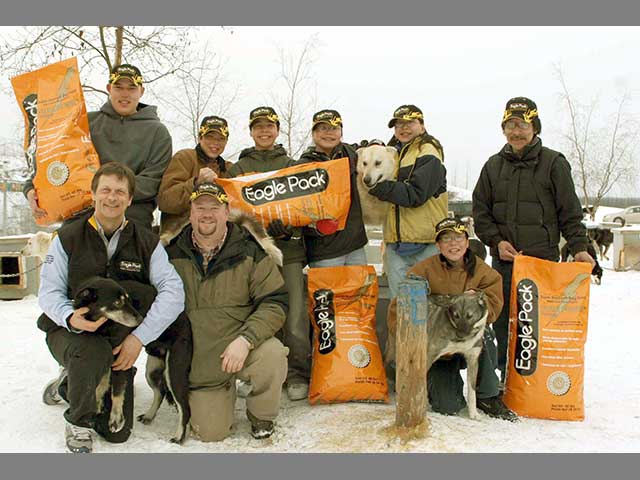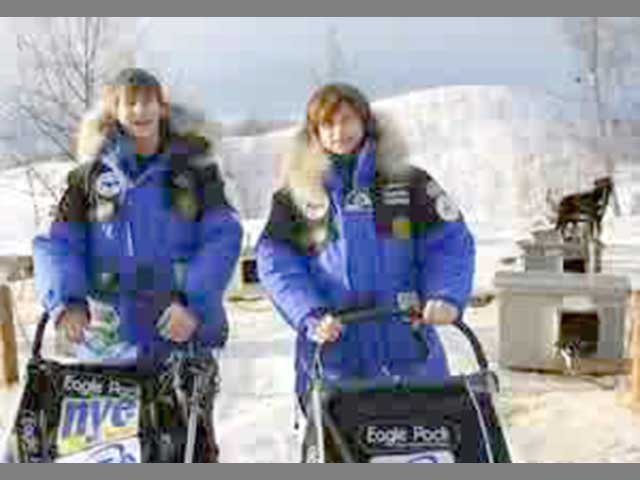Today's Class – Mush!


Well, kids in Tuluksak, Alaska, actually have a dog-sledding class. Mike Wood is the teacher. His class has students aged 12 to 17. Their classroom is outside, where 20 dogs are ready and waiting. When the dogs see the students, they go wild, jumping and howling with joy. "These are really nice dogs," Mr. Wood says. "But they have a lot of energy. When the kids come in, the dogs pull at their coat sleeves. Not because they're aggressive, but just to get their attention."
Martin Buser raises Alaskan Huskies. He helped start the dog-sledding class by donating a litter of puppies to the school a few years ago. He laughs and says, "The dogs can be a handful sometimes. But my dogs are very friendly. It's just that they want to race for a living!"
Why would a school have a sledding class? In Alaska, the parents and grandparents of the students used to have sled dogs as part of their everyday lives. They used to take care of the dogs and were deeply connected with the dogs. But today a lot of kids in Alaska don't know much about sledding. Teachers were unhappy about this and spoke to Mr. Buser. That's when Mr. Buser decided to give some of his dogs to the school. "This program connects the older generation with the younger generation," he explains.
In Alaska, there are lots of dog races. One of these races is the Junior Iditarod, which happens every year in late February. It's 150 miles long, and young racers (called "mushers") go out and compete with teams of dogs. The mushers are all under 17 years old, and they come from around the world to race in the Junior Iditarod. Each year, one of the students from Tuluksak is chosen to enter the race with the school's dog team.
But the Junior Iditarod is a long way off. Before then, the students and the dogs have a lot of training to do. Early in the school year, when there is no snow on the ground, Mr. Wood teaches some basic knowledge about dogs. "The kids learn about nutrition," Mr. Wood says. This is important, because the students need to know how calories in dog food provides energy to burn during a race. The best high-energy food for a sled dog is fish and rice. But you can't find dog food like this in stores, so students in Mr. Wood's class learn how to make the food themselves. They get fish from markets and cook it together with rice, then serve it to the dogs.
As the weather turns colder, students get a chance to hook the dogs up to a sled and do practice runs. They start off with wheels on the sled. But it's not as easy as it sounds. The first time they do this, the dogs are jumping in different directions, pulling all over the place, and bumping into each other. Some of the dogs don't get along and fight. How do you get the dogs to all run in the same direction? Mr. Wood teaches right from the beginning how to be patient, and how to be confident. Students learn how to be leaders, so the dogs will listen to them.
Little by little, each day, as students learn to get the dogs to listen, the dogs pull the sled faster and faster. Everyone comes together as a team. But they are still a while away from the race!
In November, there is some snow on the ground. Now there are longer races with the dogs, without the wheels. Students also practice the commands. They yell "gee" when they want the dogs to turn right and "haw" when they want the dogs to turn left. "These are the same commands used in the real races," Mr. Wood says. The dogs are learning what each command means, and students are learning how to say it clearly, with confidence. It's one of the most exciting feelings when the dogs listen and turn on command while the sled is racing through the snow.
Everyone is having a lot of fun. But sometimes, there is some dirty work. "Every day, we have poop detail!" Mr. Wood explains. Students are responsible for keeping the dog houses clean, which means heading out with pooper scoopers. They also check each dog's fur and clip each dog's nails. "The kids are learning how to really take care of a dog," Mr. Wood says. "They learn to see every detail. With sled dogs, you can't leave anything out." Mr. Wood says the dogs don't like having their nails clipped or their fur brushed. But this is another lesson in leadership. "The kids learn that with the right attitude, the dog will let them do these things," Mr. Wood explains.
December and January rolls around. Students see what winter is like with the dogs. They come in on Monday morning. It's freezing cold, wet, and dark. But it doesn't matter. They still must get out there and take care of the dogs. "They learn responsibility," Mr. Wood says. "I tell my students, even if it's 20 degrees and snowing, those dogs have to eat. They are depending on you!"
The team is working out great. The dogs race faster and listen to commands, and the dogs are all healthy. Students know that this is all because of their patience and hard work. Now it's time to pick the Junior Iditarod team. Mr. Wood has a difficult decision. He has several terrific students in his class. But a rule of the Junior Iditarod is that only one musher is allowed to race. "The kid who shows the most initiative gets to be musher," Mr. Wood says. In 2006, that was Robert Tikium. He was 16 years old when he was chosen to be Tuluksak's musher.
Robert says it was an amazing feeling to race with the dogs, and he felt a close connection with them. "When I finished the race," he says, "I got down on the ground and I talked to the dogs. I just kept saying, 'Good dogs, good dogs.' They were really excited when they finished the race." Everyone in the school and the town was also excited. They all came out to congratulate Robert on his achievement.
Mr. Buser says that everyone can learn some of the same lessons as the students in Tuluksak. "If you learn to take care of another being, you'll also learn to take care of your fellow human. It all fits together nicely."
Robert Tikium plans to keep sledding as he gets older. But he will never forget the dogs he raced with at Tuluksak. "The Junior Iditarod is a long, cold race," he says with a laugh. "But it was a lot of fun. The dogs taught me a lot about working hard and going long ways together. They really got to know me. We were a team."
